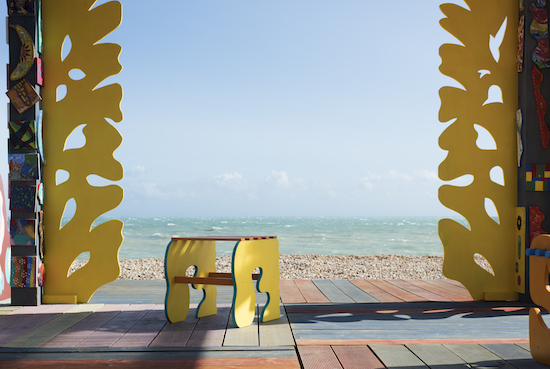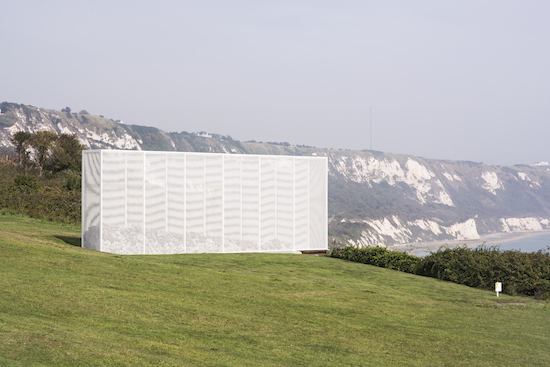Alex Hartley, Wall, commissioned by the Creative Foundation for Folkestone Triennial 2017. Image by Thierry Bal
Rule one as a reviewer – don’t read other reviewers reviews before you’ve written yours. For once I couldn’t resist. To be precise I saw a headline on the KentLive webpage: A top art critic has slammed the Folkestone Triennial as “underwhelming” and “contemptuous”. Contemptuous, eh? Yikes, that’s harsh, that’s bed-wettingly astringent…
So of course I went on to check the offending article and winced at its superior talk disdaining Folkestone as having not the pavilions and palaces of Venice with its glammy Biennale but “boat terminals and hard-to-let terraced housing”. Now as it happens I’d enjoyed a very fine day out; I’d never been to the Folkestone before. The town is a pleasant surprise having little of the sleazy character of its neighbours – the drab dinginess of Dover, the pirate-day buffoonery of Hastings. And so I stopped reading the broadsheet just at the point where I thought the puntillero had his dagger now well and truly raised. But too late; I’d swallowed that piercing word – underwhelming – and I couldn’t help but think again; was my first upbeat impression a tad over influenced by some of the town’s other delights? Had those superb white chunks of cod for lunch made for too benign an impression? Were those mushy peas spiked?
Let’s think back. The first work encountered was Bob and Roberta Smith’s laudable project Folkestone Is An Art School (all works 2017 unless stated) – a four-part affair that features the aforementioned title as a declaration displayed in various sites around town. Particularly effective was the giant banner seen lining the circular walls of an old Martello Tower on a hill overlooking the sea. There were also teaching programmes sited in a corner building near the dock. A commendable idea but arguably a Canute-like gesture given the gales of reality battering against the current levels of funding allocated for art education in the UK.
Next up was a walk along the old tracks leading to the derelict harbour station, now being redeveloped in a (shortened) manner similar, if you squint in the right direction, to the Manhattan High Line. In the harbour itself floats one of Richard Woods’ little houses, part of his work called Holiday Home. There are six of these one-third size ‘homes’ done in different colours on various sites around the town. We glean that the artist intends to highlight the escalating housing crisis. A pattern is hinted at as we walk – some of these artists here are really pissed off.
We aim east and, high above the sea, come across Marc Schmitz and Dolgor Ser-Ord’s Siren. This is a sculpture of a giant ear trumpet with a bright yellow drum that references the old acoustic mirrors along the coast at Dungeness, once used in the fearful pre-radar days to listen out for the approaching Luftwaffe. There’s a sense of déjà vu here – Tacita Dean did a film about these weird ruins some time back called Sound Mirrors (1999) and this more spookily conveyed the dread of that time and the odd alien nature of these military remains.
The most resonant of the works from this iteration of the Triennial comes into view next – Alex Hartley’s Wall. What looks like gabion fencing is placed overhanging the cliff edge. You think ‘cage’, you think of the refugee ‘Jungle’ at Calais, the fragility and arbitrariness of borders, you remember that tabloid drivel about imminent mass immigration. The cage is filled with stones – querns actually, millstones from the Iron Age. These chime with the obvious erosion witnessed on the cliff walls. Hard not to suspect Hartley despairs our humanity these days, sees the quality of mercy on these islands eroding too.

Sol Calero, Casa Anacaona, commissioned by the Creative Foundation for Folkestone Triennial 2017. Image by Thierry Bal
Heading back west now and it is difficult at first to find David Shrigley’s contribution – Lamp Post (as remembered). You keep looking at a line of street lamps done in the kind of cheerfully ornate design one associates with trips to the seaside. Part of the fun of the Triennial is playing a variant of the game ‘Find What the Sailor Has Hidden’ that Nabokov talks of at the end of Speak, Memory. At last I work out which one I’m supposed to be looking at. Shrigley asked a friend to memorize the posts for 40 seconds and then draw one – this then becomes the design of a newly constructed light to be placed discreetly amongst the originals. As Nabokov has it of discovery – ‘the finder cannot unsee once it has been seen.’ I’m a big fan of street lighting co-opted as Art but the Shrigley pales somewhat in comparison to the massed ranks of lamps that feature in Chris Burden’s masterful Urban Light (2008) shining brightly on Wiltshire Boulevard, L.A.
A Bill Woodrow work called The Ledge isn’t here – not his fault, the ledge is still on the edge of production apparently. The Michael Craig-Martin and Antony Gormley works are, well, by Michael Craig-Martin and Antony Gormley. I’ll admit that one of the Gormley pair Another Time XXI 2013 (Coronation Parade) and Another Time XVIII 2013 (Loading Bay) is suggestively situated underneath the arches of the old railway. There’s a couple of sparky wee pavilions on the pebbly beach, one called Jelly Mould Pavilion by Lubaina Himid – up this year for the Turner Prize – and the other, Casa Anacaona, by Sol Calero. Each conjures memories from warmer climes but being so openly exposed to the freezing Channel contrive to make you feel colder.
A truly positive facet of the Folkestone Triennial is the decision to retain a few old pieces from previous outings. And so you encounter Michael Sailstorfer’s treasure hunt Folkestone Digs (2014) in a curve of sand where some buried gold pieces are apparently still to be found. Nearby is Cornelia Parker’s The Folkestone Mermaid (2011) – a gag on Hans Christian Andersen, it being a statue of a local woman who you could imagine to be the mum of that little lady from Copenhagen. West of the town centre is a work where the title says it all – Pablo Bronstein’s LOL construction Beach Hut in the Style of Nicholas Hawksmoor (2014). Two quietly moving works are to be found close to the town’s war monument commemorating the thousands who sailed from Folkestone to their deaths in the trenches. Christian Boltanski’s sound piece The Whispers (2008) features voices reading letters from the doomed and Mark Wallinger’s Folk Stones (2008) silences you by the economic use of hundreds of numbered pebbles in a large but simple square of land on the prom, each of which stands for one of the British soldiers killed on the first day at the Somme.
So what then if the Triennial is not as good this year as it has been in the past – as if that weren’t the case for Venice and its Biennale too. As for ‘contemptuous’ – some could argue that, hey, there’s no shortage of cynicism over on the lagoon right now. One thinks of those gaudy fake treasures from the deep by that shark fella. Stick with the real in Folkestone – and remember that battered cod.
The Folkestone Triennial is on until 5 November


